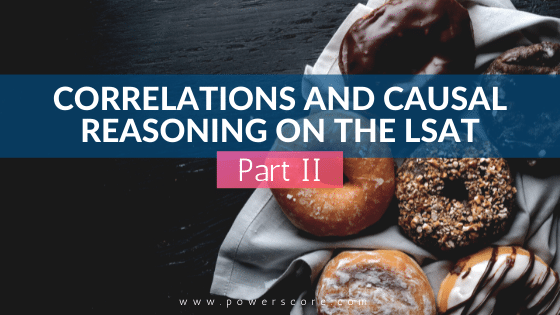This is the second article in a series that discusses Correlations and Causal Reasoning on the LSAT. Here is a typical stimulus containing a causal conclusion supported by a correlation.
Advertisement:
Pump3D is a nutritional supplement that can greatly reduce athletes’ fatigue after anaerobic exercise. This was shown by a study investigating the relationship between fatigue and high doses of guarana extract—the main ingredient in Pump3D which showed that people who regularly take guarana extract supplements have a significantly lower level of fatigue after anaerobic exercise than people who do not take the supplement.
The key to weakening an LSAT argument is to focus on the conclusion. It is essential to break down the argument. The conclusion is the first sentence in the stimulus, in support of which the author describes the results of one particular study. A premise indicator is “this is shown by”.
Premise: People who regularly take guarana extract supplements have a significantly lower level of fatigue after anaerobic exercise than people who do not take the supplement.
Premise: Guarana extract is the main ingredient in Pump3D.
Conclusion: Pump3D can greatly reduce athletes’ fatigue after anaerobic exercise.
The advertisement’s conclusion is based on a questionable assumption. The study only establishes a correlation between a lower level of fatigue and guarana supplementation. While there are many ways of attacking the conclusion, most will require undermining the reliability of the study or experiment.
Attack the Conclusion
- Was the study properly controlled? In other words, are we sure that the subjects who did not take guarana supplementation had the same baseline fitness level as those who did?
- Do we have any reason to suspect that taking supplements would have a placebo effect that would lead the study group to overestimate the degree to which their fatigue has been reduced?
- Is it possible that the researchers themselves have a bias in favor of discovering the sought-after effect?
Question the Relationship
We can also weaken the argument by questioning whether the causal relationship can be explained by a third, independent factor. What if people who typically experience lower level of fatigue because of a third, unrelated factor (above-average fitness level, other nutritional supplements, etc.) also tend to take Pump3D? This would imply an alternate cause for the observed effect.
With this in mind, take a look at the following two questions. Feel free to submit your answers in the Comment box below. We’ll review the correct answers and the explanations in Part III of this blog article.
Weaken
Which of the following, if true, would most weaken the argument in the advertisement?
- Guarana extract supplements tend to reduce slightly athletes’ endurance and stamina during aerobic exercise.
- People who regularly consume guarana extract supplements tend to be professional athletes, who rarely experience fatigue after exercise.
- Guarana extract is only one of several ingredients in Pump3D.
- The reduction in fatigue due to the consumption of guarana extract is no greater than the reduction due to other nutritional supplements.
- Guarana extract taken in the form of supplements has a different effect on the body than does guarana extract taken in food.
Assumptions
Which one of the following is an assumption required by the argument?
- The belief that a nutritional supplement would have a certain effect can sometimes produce that effect.
- Those who regularly take guarana extract do not undertake unusually strenuous exercise regimens that are otherwise conducive to experiencing fatigue.
- People who avoid taking nutritional supplements are not more likely to have a healthy, well-balanced diet that combats fatigue.
- People who regularly take guarana extract are not significantly more likely than those who do not consume caffeine, a known stimulant that decreases fatigue.
- Consuming guarana extract has few serious side effects.


Disha says
What are the correct answers in the weaken and assumption?
Dave Killoran says
They are listed in part 3 of this blog: https://blog.powerscore.com/lsat/bid-229594-correlations-and-causal-reasoning-on-the-lsat-part-iii/
Thanks!